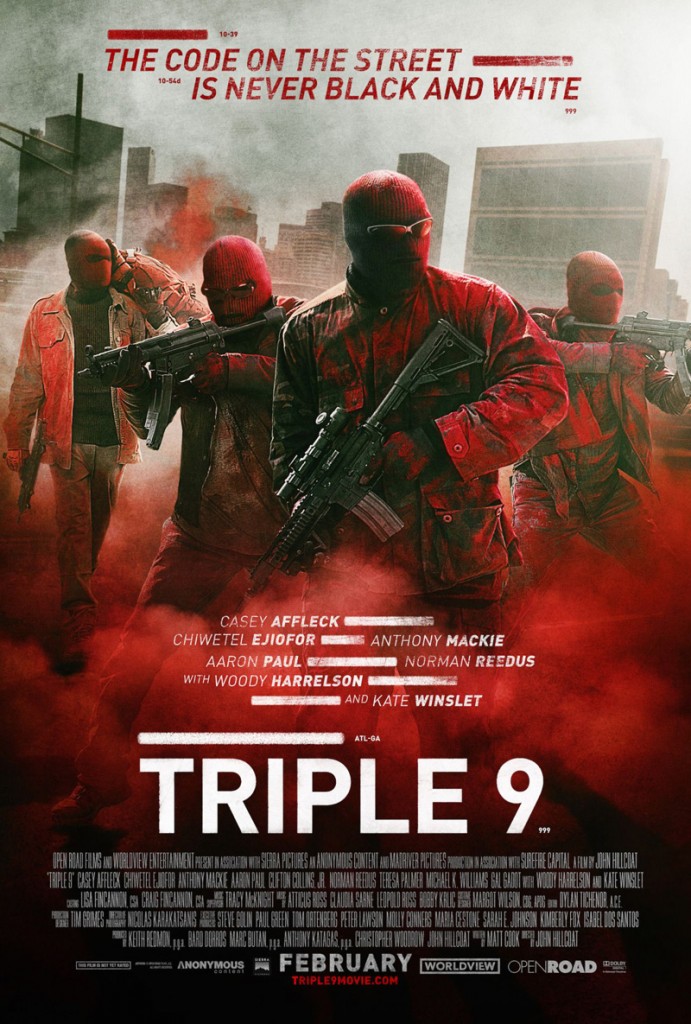Movie Breakdown: Triple 9 (Noah)
Pre-Screening Stance:
John Hillcoat made The Proposition. John Hillcoat made The Road. John Hillcoat made Lawless. My level of hype was so high for Lawless that its crushing terribleness soured me right badly. Triple 9, please, be the sweet to my sour.
Post-Screening Ramble:
Looking back at The Proposition, I think it hides some of director John Hillcoat’s biggest problems under the cavalier, and brilliant, stylings of a first-time director. It’s a great film, but one that eschews the norms of traditional, coherent story-telling, in favor of a bleak, near-hallucinogenic, Australian walkabout peppered with feverish bouts of violence. I love it, because I love hallucinogenic violence, but looking back now, after watching the “evolution” of Hillcoat’s cinematic career, I wonder if the film’s slight storyline and visual acuity were simply red flags we discounted because it was still in the shiny, honeymoon phase of Hillcoat’s filmography. Now though, after the immense letdown of Lawless, I approached Hillcoat’s newest film, the modern-day crime caper Triple 9, with a sack full of worries about what the director might bring to the table. Triple 9 feels, for the most part, like the modern day equivalent of Michael Mann’s Heat. It follows a crew of dirty cops and ex-special forces members led by Chiwetel Ejiofor (in full they were trying to cast Denzel Washington mode) trying to pull off a particularly impossible heist involving the Russian Mob, an NSA safe deposit box, and the planned murder of a rookie cop (Casey Affleck, proving that even in a supporting role, he’s still a standout). For almost the entire running time, the film hurtles forward at a sickening pace, taking us from the mean streets of Atlanta (and Hillcoat does not shirk his audience on the grim and gritty portrayal of a city with a massive wealth gap; seriously, Atlanta looks like beautiful shit in this film) to the fluorescent lit hallways of the ATLPD to the mansions of ATL’s wealthiest regions. It’s grim and gritty and Hillcoat, never a slouch visually, makes you feel every crackhead’s stare, every gang members mean mug, every abandoned project’s broken glass and cracked concrete. And, like any good crime flick should, the hideous exteriors reflect the corruption that lives at the hearts of its characters. Everyone gives their all in this piece (Anthony Mackie’s corrupt cop with a heart of a gold and Woody Harrelson’s drug-addled Captain are standouts) and even though it’s stacked with famous faces, Hillcoat manages to make the film feel authentic and lived in. But it’s Hillcoat’s issues with story that drag him down. The film is too full – of plot and characters and just stuff – and as it loafed towards its conclusion (the film slows down considerably when it should be picking up) this reviewer started becoming concerned that unless this was the first film in a secret, planned trilogy, Hillcoat had little-to-no chance to stick the landing. He is not planning a Triple 10 and boy-oh-boy does he fumble the last fifteen minutes of the film. It is a testament to the well-crafted, extremely tense first 9/10 of the film that an ending this bad forces you to think, “Did I miss something?” instead of “worst film ever.” At this point, one has to wonder if this is just the director Hillcoat is – a visual genius who places well staged action scenes (and there is a doozy of a police raid in this film) over a cohesive story – and that maybe The Proposition is just a lucky stab by a first-time director.
One Last Thought:
I want nothing more than for John Hillcoat to hit his stride and produce movies this beautiful that aren’t hampered by terrible endings of excessive storylines. Until he does, I’ll keep approaching his films with the same wariness I approached this one.


